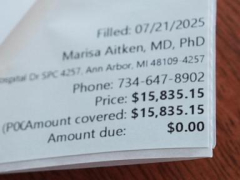Delayed treatments, canceled doctor visits, skipped prescriptions. Losing insurance is bad for your health.
The Congressional Budget Office forecasts that the U.S. uninsured population will grow by 10 million in 2034, due to the tax and spending bill signed into law by President Donald Trump.
And, thanks to a natural experiment nearly two decades ago, researchers can forecast what that will mean for patient care. Among the problems they predict will develop as a direct result of these people losing coverage:
— About 2.5 million people may no longer have a personal doctor.
— About 1.6 million patients will take on medical debt.
— The lack of care may cause nearly 22,000 deaths annually.
“There’s really no questioning the basic reality that you can’t take health care away from 10 million people without causing many preventable deaths,” said Dr. Adam Gaffney, lead researcher on a team that explored the new law’s impact.
Here’s a deeper look at the research and challenges that could develop.
It will become harder for many people to enroll in Medicaid or individual insurance plans and then stay covered. Medicaid is a state and federally funded program that covers care for people with low incomes.
States will have to verify every six months whether someone remains eligible for Medicaid. That could cause coverage lapses for people with incomes that fluctuate or for those who move and miss renewal paperwork.
Many also are expected to lose coverage as states require Medicaid recipients to work, volunteer or go to school unless exempted.
Enrollment in Medicaid has swelled in recent years. Republicans are cutting back in part to help fund tax breaks and pay for other priorities like border security. They also say they are trying to root out waste and fraud by rightsizing Medicaid for the population it was initially designed to serve — mainly pregnant women, the disabled and children.
People covered through the Affordable Care Act’s individual insurance marketplaces also will see shorter enrollment windows and no more automatic renewals.
Gaffney, of Harvard Medical School, and other researchers looked to past studies to measure how many people would experience detrimental effects, like going without prescriptions, from the upcoming changes. Gaffney updated the published analysis, which was originally based on the House version of the bill, at the AP’s request.
One study in particular was critical for their work: In 2008, Oregon offered a rare opportunity to compare groups of people enrolled in Medicaid with those who were not.
After a four-year period of frozen enrollment due to budget limitations, the state determined it could enroll 10,000 more people in Medicaid. It used a lottery system to make the selection amid high demand.
That gave researchers a chance to follow people who got coverage and those who did not, similar to how scientists testing a new drug might compare patients taking it to those given a placebo.





